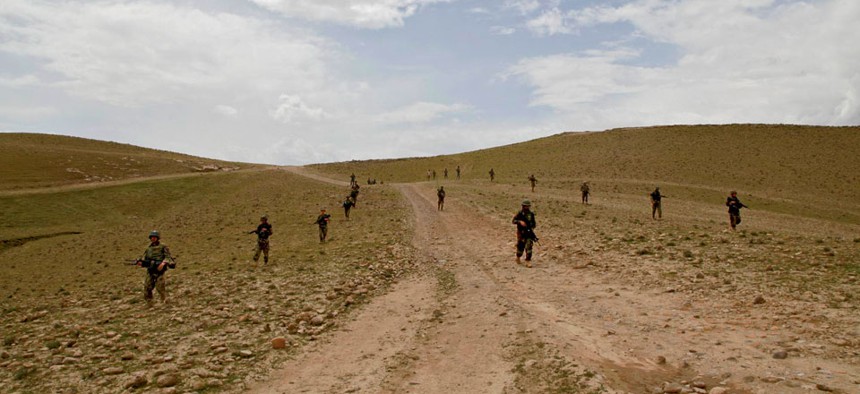
As Afghan National Security Forces take the lead in the region, they face remnants of insurgent groups and criminals. Defense Department
Is This How It Ends in Afghanistan?
As al Qaeda’s power dwindles, the Taliban and criminals could capitalize on instability in the region.
During the invasion of Iraq in 2003, then-Maj. Gen. David Petraeus, who was commanding the 101st Airborne Division, famously said: “Tell me how this ends.” The U.S. military learned some hard lessons in Iraq that it hopes not to repeat in Afghanistan, and one of those is that success looks different in different parts of the world.
With most coalition forces beginning to draw down by early next year, the enemy landscape is beginning to play out in a way that could become the new normal in Afghanistan: a few remaining al Qaeda and Haqqani members looking to hit Western targets, a pliable Taliban searching for a piece of the political pie with the hope of returning to strict Islamic rule and criminals trying to take advantage of it all.
Gen. Joseph Dunford, the top U.S. commander in Afghanistan, says there are only about 75 members of al Qaeda left in the country. The Taliban is positioning itself for some sort of political solution with the government of Afghanistan. The Haqqani network is largely confined to the P2K area of Paktia, Paktika and Khost on the Pakistan border. And the rest of the bad actors appear to be criminals looking to make a buck off the instability, corruption and flow of goods and opium going in and out of the country.
Casualty reports from the International Security Assistance Force in Afghanistan are now using the term “enemy of Afghanistan” when describing who attacked them. They used to say “insurgent attack.” And these enemies are now up against a 350,000-strong Afghan army, local police and tens of thousands of U.S. and NATO troops.
“You have to be careful when you try to define who you’re fighting against,” says Brig. Gen. Joseph Osterman, deputy chief of staff for the ISAF Joint Command. “It’s one of those things that if you try to define who the Taliban is or who the Haqqani
is . . . you kind of start crossing yourself in terms of what the motivation is.
“We do see all of these groups in combinations,” he says. “You’ll see the Haqqani
network in and around the Kabul area; you’ll see the Taliban a little bit more widespread; you’ll see, for example, the folks involved with these kind of half-insurgency, half-criminal activities that are prevalent near the Helmand area where the poppy is growing. That’s kind of the mosaic. And there’s a criminal element of this whole thing that frankly is just all from an economic standpoint. It’s all about money, it’s all about commerce, it’s all about jockeying for commercial relevance and power in certain areas.”
The “enemy of Afghanistan” has also become more transient, especially with other fights to be had in hot spots around the world.
“We have seen reporting that indicates that certainly some of them—al Qaeda being probably the most prominent, which is relatively small remaining presence here in Afghanistan . . . are looking to, in some cases talking about, meeting glory in Syria or Egypt or Yemen,” says a senior U.S. military official in Afghanistan, speaking on condition of anonymity. “And in some cases, those that went back to Pakistan for Ramadan may not come back to Afghanistan afterwards and may go somewhere else.
“It’s somewhat complex,” the official says, “because it’s not simply the insurgency [groups] that are causing problems. This area of the world has had a history of illicit trade, of narcotics, of any number of things that have created power brokers and influential people that have a lot of different agendas. Some of these folks have a distinct desire to see the status quo remain just like it is because they’re able to have some freedom of movement and make an awful lot of money. So it’s not simply al Qaeda.”
In fact, al Qaeda is “just surviving, not thriving here,” the official says. “A couple of years ago we probably would have seen reporting where al Qaeda operatives were helping facilitate Taliban and other groups. Now we’re kind of seeing where these other groups [and the] Taliban are helping the remnants of al Qaeda.”
With Afghan security forces now mostly in the lead, Osterman says, the enemy is further destabilized, and not just tactically. “What we’re really seeing more here is these various factions that are now questioning why they’re fighting and what they’re fighting for,” he says. “You’re actually seeing some of them kind of dissolve, if you will, back into society. They just get tired of fighting.”
The biggest threats seem to be not from al Qaeda at all, officials say. Rather, they are from the Taliban—which had a long history in Afghanistan before the United States showed up in 2001—and from criminals.
Tough economic conditions are always good for the Taliban, which argues that the government of Afghanistan is corrupt and unable to provide for its people. “As long as those conditions continue to exist, there’s an ability for the Taliban to continue to regenerate,” the senior U.S. military official says. “I think that we’re getting to the point, certainly now with the [Afghan National Security Forces] in the lead, I think there are leaders within the Taliban that acknowledge or recognize that a military solution is not going to get them ultimately what they want.”
Afghanistan won’t be completely rid of violence among its warring factions anytime soon, but with the end of the war nearing in 2014, the military and political chips are beginning to fall into place.
“I think ultimately there’s going to have to be some political reconciliation effort and think there are some senior members of the Taliban and some senior members of these insurgency groups that are beginning to recognize that. And not all of them are going to follow that,” the official says. “Clearly the Haqqani [network] is a capable organization. It is localized in the P2K area, that’s their homeland. There are going to be some organizations that are completely opposed to reconciliation and may continue this fight for many, many years.
“I think we’ll get to a point with
successful elections [in 2014], with successful growth in the ANSF and greater capacity, greater capability, greater confidence—and we have a peaceful transition here—that ultimately these groups don’t reconcile [and] over time become irrelevant,” the official says.
NEXT STORY: Pentagon Prophecies







